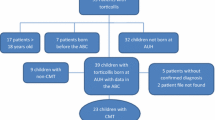Summary
A statistical study was done to determine the incidence of congenital torticollis. The aetiological relationship between torticollis and obstetrical paralysis was analysed in an attempt to clarify the possible cause of torticollis.
There were forty-three cases of torticollis in the 2,160 babies delivered at the Otsu Red Cross Hospital from 1978 to 1981.
The overall incidence of torticollis was 1.9%; 1.2% in cephalic presentations, 6.5% in double breech presentations, 4.2% in footling presentations and 34.0% in single (frank) breech presentations.
In addition, forty-three cases of obstetrical paralysis treated in Kyoto University Hospital from 1961 to 1981 were reviewed. Torticollis was found in 26% of the cephalic presentations (6 out of 23) and in 80% of the breech presentations (16 out of 20) respectively.
These findings suggest that a foetal posture with both the knees and the cervical spine extended seems to be closely related to the development of torticollis, which indicates that a direct cause may be stretching of the sternocleidomastoid muscle during delivery.
Résumé
Une étude statistique a été effectuée portant sur la fréquence du torticolis congénital, et les relations étiologiques entre le torticolis et la paralysie obstétricale ont été analysées pour essayer de déterminer la cause du torticolis.
43 cas de torticolis ont été observé sur les 2.160 accouchements effectués à l'Hôpital de la Croix-Rouge d'Otsu, de 1978 à 1981.
La fréquence totale des torticolis a été de 1,9%: 1,2% pour les présentations céphaliques, 6,5% pour les présentations du siège doubles, 4,2% pour les présentations des pieds et 34,0% pour les présentations du siège simples.
43 cas de paralysies obstétricales traitées à l'Hôpital Universitaire de Kyoto de 1961 à 1981 ont également été étudiés. Un torticolis était associé dans 26% des présentations céphaliques (6 sur 23), et dans 80% des présentations du siège (16 sur 20).
Ces constations donnent à penser qu'une position du foetus où genoux et vertèbres cervicales sont en extension et étroitement liée à l'apparition du torticolis, et que la cause directe pourrait en être l'élongation du muscle sternocléidomastoïdien au cours de l'accouchement.
Similar content being viewed by others
References
Albee FH (1919) Orthopaedic and Reconstruction surgery. pp. 929–936. Saunders Co., Philadelphia, London
Chandler FA, Altenberg A (1944) Congenital Muscular Torticollis. JAMA 125: 476–483
Fisher AL (1916) Torticollis — a Review. Am J Orthop Surg 14: 669–681
Kiesewetter WB, Nelson PK, Palladino VS, Koop CE (1955) Neonatal Torticollis. JAMA 157: 1281–1285
Von Lactum HL (1929) Torticollis, Removal in Early Life of the Fibrous Mass from the Sterno-mastoid Muscle. Surg Gynecol Obstet 48: 691–694
Ling CM, Low YS (1972) Sternomastoid Tumor and Muscular Torticollis. Clin Orthop 86: 144–150
Middleton DS (1930) The Pathology of Congenital Torticollis. Br J Surg 18: 188–204
Petersen F (1884) Caput Obstipum. Langenbecks Arch Chir 30, 4: 781–798
Petersen F (1886) Zur Frage des Kopfnickerhämatoms bei Neugeborenen. Zentralbl f Gynäkol 48: 777–779
Petersen F (1892) Über den angeborenen muscularen Schiefhals. Z Orthop Chir 1: 86–113
Sanerkin NG, Edwards P (1966) Birth Injury to the Sternomastoid Muscle. J Bone Joint Surg [Br] 48: 441–447
Sippel P (1920) Der angeborene muskulare Schiefhals. Dtsch Z f Chir 155: 1–48
Stromeyer L (1838): Beiträge zur operativen Orthopädik oder Erfahrungen über die subcutane Durchschneidung verkürzter Muskeln und deren Sehnen. Helwing, Hannover, pp 128–151
Author information
Authors and Affiliations
Rights and permissions
About this article
Cite this article
Suzuki, S., Yamamuro, T. & Fujita, A. The aetiological relationship between congenital torticollis and obstetrical paralysis. International Orthopaedics 8, 175–181 (1984). https://doi.org/10.1007/BF00269913
Issue Date:
DOI: https://doi.org/10.1007/BF00269913




